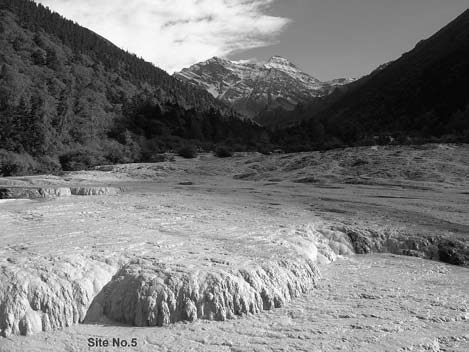Spatial and temporal hydrochemical variations of the spring-fed travertine-depositing stream in the Huanglong Ravine, Sichuan, SW China
DOI:
https://doi.org/10.3986/ac.v39i2.97Povzetek
Automatic hydrochemical logging and in situ titration combined withlaboratory analysis were used to understand the spatial and temporal hydrochemical variations of the spring-fed, travertine-depositing stream in celebrated Huanglong Ravine, Sichuan, SW China. This is essential for protection of the Huanglong World Natural Heritage travertine landscape. It was found that the deposition of travertine was due to very strong CO2 degassing from the water, leading to decrease in pCO2 and specific conductivity (SpC), and increase in pH and SIc downstream from the Spring. However, regular downstream hydrochemical evolution was interrupted by dilution withsnow-melt water and by renewed CO2 from some downstream springs. The chemistry of Huanglong Spring itself was stable at a diurnal scale thoughit was altered by the great Wenchuan earthquake of May 12 2008. However, in spring-fed pools downstream, pCO2 and SpC were lower, and pH and SIc were higher in daytime than at night, whichindicates that the deposition of travertine was faster during the daylight hours. This was due to the combined effects of higher water temperatures and higher aquatic algae photosynthesis. In addition, it was found that the phosphate concentration in the stream increased remarkably downstream in the tourist midseason, indicating water pollution by tourism activities. The increase of phosphate (an inhibitor of calcite precipitation) may be one of the reasons for the decrease in travertine deposition rates and accelerated propagation of discoloration by diatoms during the past decades, whichneeds to be given more comprehensive study and tackled in future for the protection of these world famous travertine deposits.Prenosi
Podatki o prenosih še niso na voljo.

Prenosi
Objavljeno
2010-06-01
Kako citirati
Wang, H., Liu, Z., Zhang, J., Sun, H., An, D., Fu, R., & Wang, X. (2010). Spatial and temporal hydrochemical variations of the spring-fed travertine-depositing stream in the Huanglong Ravine, Sichuan, SW China. Acta Carsologica, 39(2). https://doi.org/10.3986/ac.v39i2.97
Številka
Rubrike
Original papers
Licenca
Avtorji jamčijo, da je delo njihova avtorska stvaritev, da v njem niso kršene avtorske pravice tretjih oseb ali kake druge pravice. V primeru zahtevkov tretjih oseb se avtorji zavezujejo, da bodo varovali interese založnika ter da bodo povrnili morebitno škodo.
Podrobneje v rubriki: Prispevki




